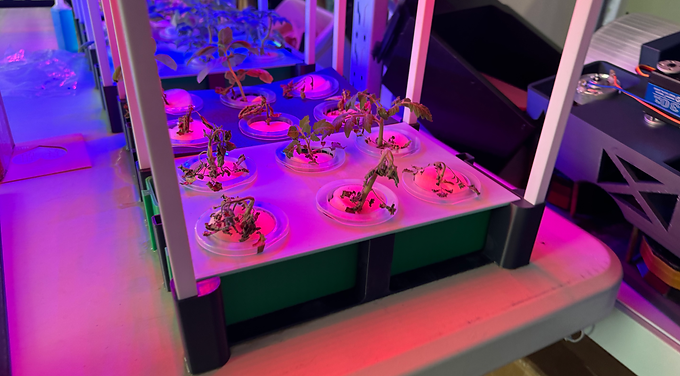

A GrowStation Control Study: The Impact of Arbuscular Mycorrhizae and Light Controls on Basil and Tomato Growth
My aquaponics system ultimately inspired this project, not because it introduced sustainable agricultural methods such as aquaponics and organic farming, but because it presented their downfalls: high cost, low yields, and success in only specific conditions. If integrated into agriculture, I believe that AMF can play a key role in balancing sustainability with affordability and are a step in the right direction to solve the environmental issues we face.


Inspiration: The Problem
The issue that inspired this project is the use of synthetic fertilizers in agriculture. Almost half of the global population is fed with crops grown with synthetic fertilizers, and they admit around 2.6 gigatonnes of carbon per year. On top of the fact that the global population is predicted to rise to 9.7 billion by 2050, I believe that the key lies in adopting sustainable agricultural practices while producing uncompromising crop yield.

AMF: The Solution
The particular solution I studied is the implementation of arbuscular mycorrhizal fungi (AMF) in producing crops. AMF are symbiotic fungi that are essential to plant growth. Benefits include increased water & nutrient uptake and resilience to environmental stress and disease. There are many studies that detail AMF’s positive effects on plant growth, but there have been few that study AMF in combination with different light types. Therefore, this study also provides a correlation between AMF and light conditions.

Research Questions
1. How do types of light affect the growth of basil and tomato plants? 2. How do types of light affect mycorrhizal-inoculated and not inoculated plants? 3. What combination of light type and mycorrhizal status yields the plant with the most growth during the duration of the experiment?

Hypotheses
Light Control Hypothesis: Basil (Ocimum basilicum) and tomato (Solanum lycopersicum) plants grown under red light will exhibit greater growth in terms of root length, root width, plant height, and plant width compared to those grown under blue and purple light. This is based on the premise that red light optimizes photosynthetic efficiency, thereby enhancing biomass production. Mycorrhizal Inoculation Hypothesis: Basil and tomato plants inoculated with arbuscular mycorrhizal fungi (AMF) will show superior growth metrics (root length, root width, plant height, and plant width) compared to non-inoculated plants, due to the AMF's role in improving nutrient and water uptake. Combined Effect Hypothesis: The most significant growth in basil and tomato plants, considering all measured parameters, will be observed in those subjected to red light and inoculated with AMF. This hypothesis combines the individual benefits of red light and AMF inoculation, suggesting a synergistic effect on plant growth.

Methods: Designing the GrowStation
Because my project is a control experiment, I decided to design my own experimental platform–dubbed the Growstation–instead of using ready-made, purchasable materials in order to control and tailor all variables in a way that fits the purpose of the experiment. That said, here are the steps: 1. Created a design on Autodesk Fusion 360 for the experimental platform. 2. Enlisted a 3D design company to produce three copies of the design. 3. Attached one set of 32.8 ft long LED light onto the roof of each GorwStation using hot glue. 4. Insertedd 2-inch garden-slotted mesh cups into each GrowStation cupholder.

Methods: Plant Preparation
1. Cultivated 36 seeds in total (18 basil and 18 tomato) in soil for 10d. 2. Inoculated half with Glomus mosseae (mycorrhizae). 3. Transferred all plants evenly into 3 GrowStations, one for each light color: red, blue, and purple.

Data Analysis
For data analysis, I focused on two criterias: relative plant growth and cell structure. Relative Plant Growth: Root length, root width, plant height, & plant width were measured (n=1296). The T-test from SPSS Statistics was used to confirm statistical significance. Cell Structure: Microscope photos were used to compare cell structure between inoculated and uninoculated plants.

Results: Plant Growth
In all metrics, inoculated plants displayed a significant increase compared to their uninoculated counterparts. Root length: Up to a 16% increase Root width: Up to a 41% increase Plant height: Up to a 34% increase Plant Width: Up to an 11% increase Additionally, most growth was observed in plants grown under blue light. For more details, see below.

Results: Cell Structure
For cell structure, microscope images showed that inoculated plant roots displayed more tightly packed cells than uninoculated ones overall. For more details, see below.

Unexpected Results
Basil inoculated with AMF and grown under red light displayed some interesting characteristics, including a longer stem, short roots, and sparse leaves concentrated towards the top of the plant. I did some research and found that these effects are similar to those of Shade Avoidance Syndrome, or SAS. SAS is a set of physiological responses displayed by plants when they perceive themselves to be in the shade, normally caused by neighboring vegetation. It is susceptible to plants under red light because of how the photoreceptors perceive R/FR wavelengths. Because of that, the plant’s modular nature makes it likely that are partitioning their resources in a way that prioritizes stem elongation (plant height) in an attempt to “outgrow the competition” and consequently, spending less energy on roots and bottom leaves. Next, I wanted to find out why these effects were so conspicuous in the inoculated group, and I found that AMF actually increases hormone production within plants, which may be the reason.

Conclusion
In conclusion, I found that plants displayed the most growth under blue light, AMF enhanced plant growth in both basil and tomato, and basil inoculated with AMF and grown under red light displayed common effects of SAS.

Next Steps
The next step would be to further explore plant hormones and SAS responses as a follow-up to my observations, and also to apply my research to real-world issues, for example, by investigating implementation of a light-mycorrhizal system so the use of AMF in agriculture can be more accessible.
Important Figures




